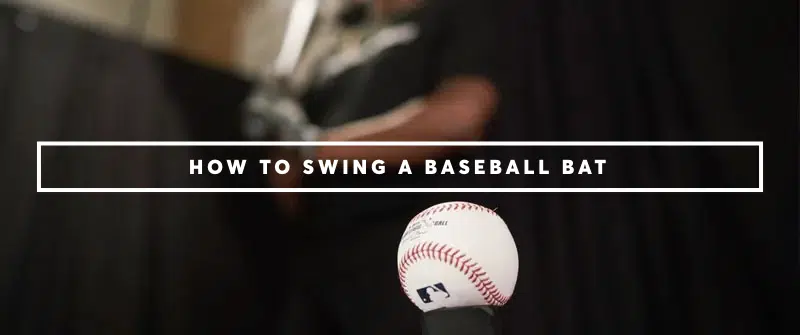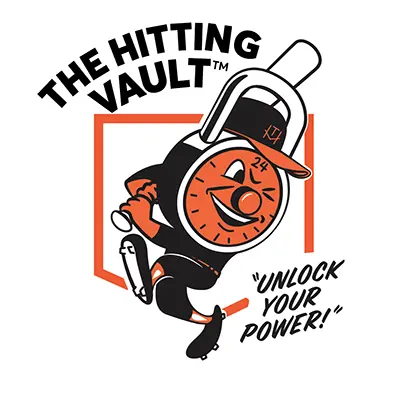How to Swing a Baseball Bat: Six Phases of the Elite Swing

If you are just starting out as a baseball player, chances are you are overwhelmed with the amount of information out there about how to swing a baseball bat. At The Hitting Vault we break down the swing into six simple steps that we call our SwingBuild Program. The SwingBuild Program is available to all members of The Hitting Vault that are looking to build a powerful baseball swing from the ground up.
Check out the six phases below of our SwingBuild program and learn how to swing a baseball bat.
Grip
There’s an outdated belief that no matter what, a hitter must have their “knocker knuckles” lined up when they grip the bat. While there are a good amount of elite hitters that do that, the vast majority do not line them up.
Instead they have the big knuckles of their bottom hand lined up with the “knocker” knuckles of their top hand (or somewhere between that and “knockers” lined up.) Not to say lining up the “knocker” knuckles is bad, but for most people that’s not comfortable.
The biggest “No-no” for gripping the bat is to have the big knuckles lined up. This tends to have the bat sitting too deep in the palms, and makes the hitter’s elbows stick out and be tense.
Stance
If you watch elite baseball and softball hitters, there is a wide range of starting stances;
- Hands high vs hands low
- Bat starting flat vs bat starting vertical
- Upright torso vs angled over
- Front foot open vs front foot straight vs starting slightly closed
The list goes on!
However, almost all elite hitters have these in common:
- 50-50 balance between their feet (even if they start open)
- Front shoulder lower than their back shoulder
- Eyes/Nose/Chin close to their front shoulder
At the Hitting Vault we encourage parents and coaches to “keep it simple” for youth baseball hitters. As they get older, getting more creative and finding out what works for them is great!
For hitters that aren’t quite at the stage for “getting creative” or adjusting to a more person specific starting stance this is what we recommend:
- Feet shoulder width apart or wider
- Hands just above their back shoulder
- Bat around 45 degrees (So not completely flat and not completely vertical to start)
- Bent knees
- Some hip hinge (being angled over)
- 50-50 balance between their feet (even if they start open)
- Front shoulder lower than their back shoulder
- Eyes/Nose/Chin close to their front shoulder
The reason for this very simple starting stance, is that youth baseball hitters don’t have very much body control so being consistent with their movements is hard. Therefore, having less movement when a hitter is younger makes it easier for them to be consistent.
Load
We love to use the term “rock the baby.” The swing mechanics with the shoulders should be similar to if you were rocking a baby. The front shoulder works down, the back shoulder works up. What we also see with most elite hitters is that their barrel works more vertical in their load. Hence why we recommend a simple stance. Because how you start in your stance determines how you load. For example, if a hitter starts with their bat flat on their back shoulder then they will have a lot of vertical barrel movement in their load, versus someone who starts with it already at 45 degrees; they would have a just little bit.
The lower half we want to load into the back hip. While it’s hard to explain over text, basically you don’t want to shift your weight outside your back foot and instead we typically see hitters stay grounded in their back foot and hinge some into their back hip. Often the front knee “coils” in towards the catcher some as well with elite hitters. The head should stay pretty still in this movement, especially for younger hitters.
We recommend for young hitters to have a small leg pick up. The higher the leg kick, they may be able to generate more power, but their ability to control their tempo and be consistent with it is not common and can cause more problems later on in their swing.
If you have a young hitter who has a more wide starting stance, having them just pick up their front foot a couple inches is great!
Stride & Separation
After the load, the hitter will then stride forward. Keep in mind that how far they stride is dependent on their starting stance. For example, if they start more narrow they will need to stride further. If they start really wide, they may not have any forward movement.
The stride needs to be controlled and not rushed. It’s like they’re falling forward, while resisting the fall, which helps keep it controlled. Often hitters push off their back foot causing them to lunge and get too much weight on their front side.
When they have finished striding and get to their front heel hitting, we call this “launch position.” Launch position is very important for a young player because it sets up the body for the rest of the baseball swing.
- Distance between your feet should be 50-60% of your height
- Front shoulder lower than back shoulder
- Knob to the catcher
- Body weight centered (okay to be slightly on the backside)
- Eyes, nose, chin lined up
- Bend in your front knee
- Front heel firm into the ground
- Long back leg with some bend
- Torso tilt/hip hinge
- Hands close to your back shoulder, and above your back foot
Some of these areas vary depending on the hitter, but these are what the majority of elite hitters do:
- Hips opened some (some hitter’s hips are closed)
- Front toes open 30-50 degrees (some hitter’s toes are pointed toward home plate)
- Striding in a straight line towards the pitcher (some hitter’s step open 3-4 inches, and some step closed 3-4 inches)
As you can see there’s a lot of little things in the launch position (when the heel hits). Having one or more aspects of it way off causes a ton of issues with the rest of the swing.
Swing Path
While there are multiple different swing paths. Some that are more flat (think Josh Donaldson), some that are more vertical (think Mike Trout), and some that are more steep to the ball (think Alex Bregman), most hitters are somewhere right in the middle of flat and vertical.
We like to use the term “see saw” with the elbows. The elbows work together in a see saw type movement, and the hitter starts to side bend. This side bending is similar to the idea of almost pinching the side, while maintaining balance and not collapsing backwards. We should see the bat work with the back shoulder in this movement, meaning the back shoulder is working down (because of the side bend) and the hands and bat work with it. If just the hands move and not the back shoulder it causes issues in the swing path.
At the same time as the elbows move and side bending happens, the lower half turns hard, that’s what ultimately takes the hands and bat towards the ball, not that the elbows and arms pushing it there. The head should stay fairly still during this time. If it were to move anywhere it would be slightly backwards, or slightly down if they’re going for a low pitch.
We have a ton of drills in the Vault that help hitters understand this path, increase bat speed and learn how to adjust to different pitch heights and locations. For example a pitch higher in the zone will have a flatter bat at contact than a pitch that is low in the zone. That one will have a more vertical bat at contact as compared to a sweet pitch just below the belt.
As the bat gets closer to contact, the front knee should firm up, this acts as the brakes. By “breaking” it allows the hands and bat to reach max bat speed right close to contact. Notice we say firm up, not lock out. Some hitters lock out their front knee, and some don’t, but it should be firm and not have their weight and head drifting forward. Hitters should feel like they are turning behind the ball after their front foot hits at launch.
Contact should have the head in line with the back knee if looking from the side, but from the front the head/spine should be tilted over. That’s due to the hip hinge at launch position. Ideally the hitter is on time, and therefore both elbows should have some bend to it. Palm up, palm down. The barrel should be lower than the hands unless the pitch is above the shoulders. The back foot should be weightless at contact, or near weightles.
Finish
The finish varies from hitter to hitter. Some hitters keep both hands on the bat, some don’t. The key is that the hitter stays on plane with the pitch. At the Hitting Vault many of our drills are focused on getting the hips to turn and feel like you show your back to home plate. Not all hitters do that, but practicing this movement helps hitters to get their lower half going.
As mentioned earlier, the front side acts as the breaks to the swing to allow the upper half to come through. Because you slam on the breaks, we should see what is similar to a “recoil” of the back foot. The back foot gets weightless as the force is going into the front side which firms up, and then it falls back. Too many hitters turn their back side and then finish balancing perfectly on their toe, similar to a golf swing. However the difference is the hitter’s feet are much wider than in a golf swing. The very end of the swing, the hitter will have weight on their back foot.
If you are looking to work on your baseball swing and want to start our SwingBuild program considering joining The Hitting Vault.



